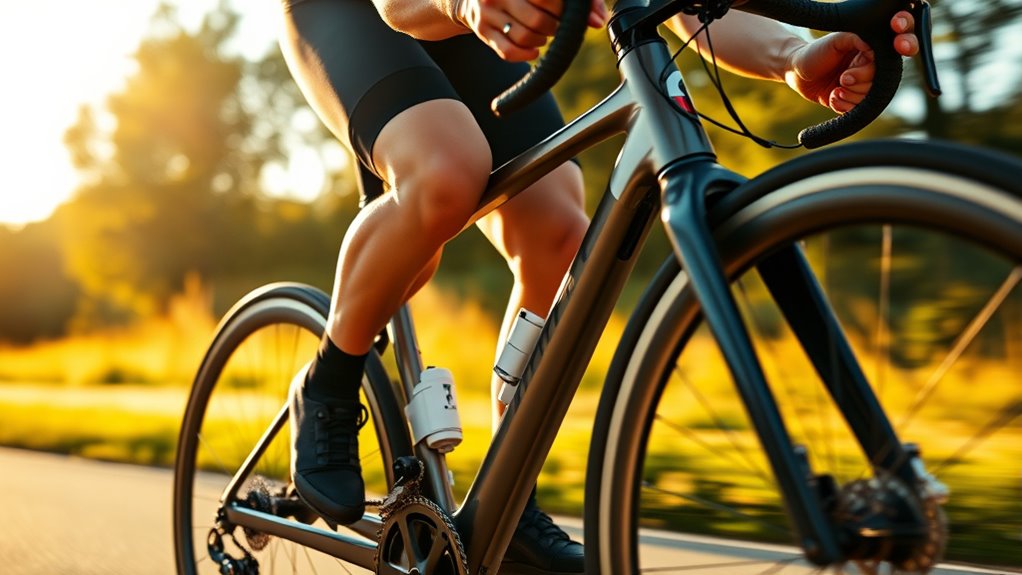To improve your cycling cadence, focus on incorporating cadence drills into your routine, such as short bursts at your target pace and single-leg pedaling exercises to refine control. Use bike computers or smartphone apps to track your progress, making small gear adjustments to find your ideal cadence. Interval training can boost speed and endurance, while steady effort helps maintain consistency during rides. Keep exploring these techniques to reveal your cycling potential.
Key Takeaways
- Incorporate cadence drills with sensors or metronomes to develop consistent pedaling rhythm.
- Perform short high-cadence bursts followed by recovery to build endurance and control.
- Use single-leg pedaling exercises to improve pedal control and identify asymmetries.
- Gradually increase drill intensity and incorporate interval sprints to challenge and enhance cadence.
- Monitor cadence with bike computers or apps, setting targets and analyzing data for ongoing improvement.
Understanding the Ideal Cadence for Your Riding Style
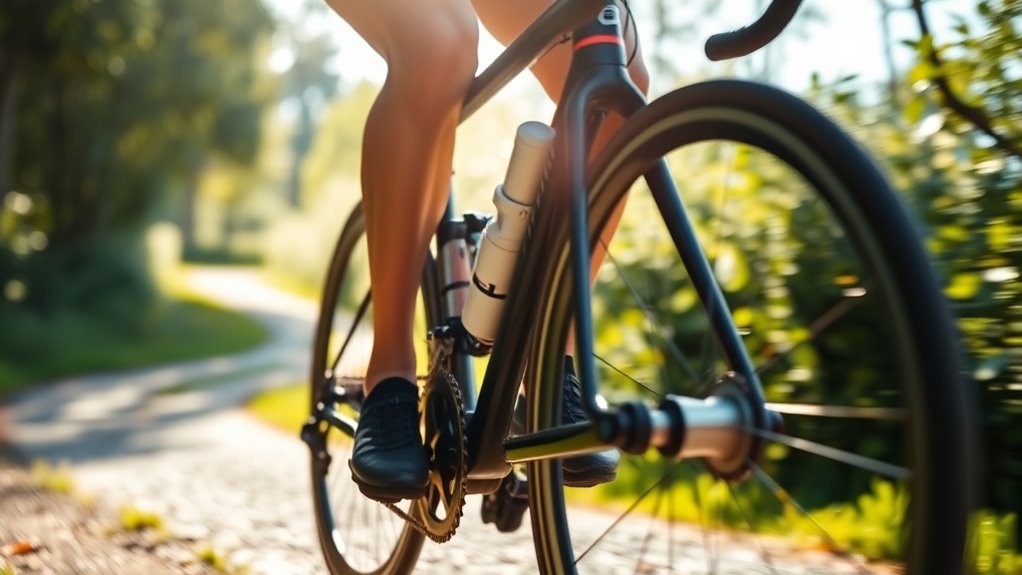
Finding the ideal cadence depends on your riding style and fitness level. To determine what works best, consider how gear ratios influence your pedal effort and speed. Lower gear ratios make pedaling easier, enabling higher cadence, while higher gear ratios require more force at a slower pace. Additionally, utilizing a high-refresh-rate setup can provide more immediate feedback on your pedal stroke, helping you refine your cadence. Your pedal biomechanics also play a role; some cyclists naturally favor a faster cadence because it reduces strain on muscles and joints, improving efficiency. Understanding cycling biomechanics can help you optimize your pedal stroke and prevent injury. Paying attention to how your body responds during rides—if you feel comfortable and maintain smooth pedal strokes—you’re likely at the right cadence. Adjusting gear ratios can help you find that sweet spot, where you maximize power without unnecessary fatigue. Moreover, adopting mindful mindfulness practices during cycling can enhance your awareness of your body’s responses, leading to better cadence control. Being aware of muscle fatigue and how it affects your pedaling can also help you make necessary adjustments for sustained performance. Remember, optimal cadence varies from rider to rider based on these factors.
Incorporating Cadence Drills Into Your Training Routine
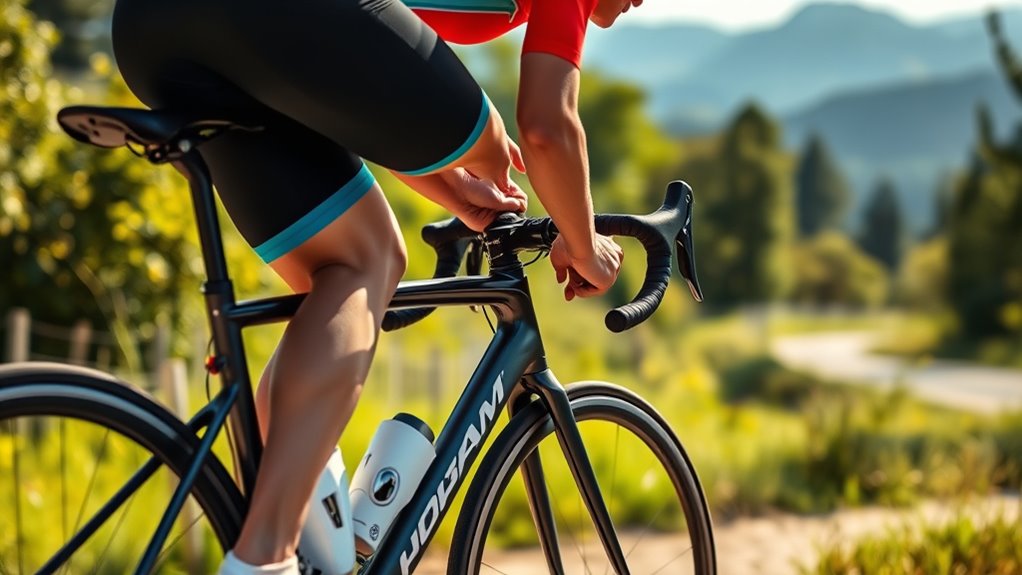
To improve your cadence, start adding structured drill sessions into your training. Focus on gradually increasing the intensity over time to challenge your muscles safely. This approach helps you build endurance and develop a more efficient pedaling rhythm. Incorporate proper lighting and environment to create an optimal space for practicing cadence drills effectively.
Structured Drill Sessions
Incorporating structured drill sessions into your training routine is an effective way to boost your cycling cadence. These sessions help improve cadence synchronization, ensuring your pedal strokes flow smoothly and efficiently. A focus on gear shifting techniques can also support maintaining a consistent cadence across different terrains. Begin with drills focused on maintaining a specific cadence, using a cadence sensor or metronome to keep consistent pace. During these drills, pay close attention to pedal stroke analysis, identifying any uneven or inefficient movements. Incorporate short bursts at higher cadences followed by recovery periods to build endurance and control. It is also beneficial to monitor your heart rate during these drills to ensure you’re training within your optimal effort zone. Regularly assessing your pedal stroke mechanics can reveal areas for improvement and help prevent injury. Additionally, integrating digital sound synthesis techniques in your training analysis can provide nuanced auditory cues to optimize your pedal rhythm. Incorporating cadence-specific drills can also enhance your neuromuscular coordination, making your pedaling more fluid. Consistency is key—perform these drills regularly to develop muscle memory and refine your technique. Over time, you’ll notice increased pedaling efficiency and a more natural, effortless cadence during your rides. Structured sessions make it easier to track progress and target specific cadence improvements.
Progressive Intensity Increase
Gradually increasing the intensity of your cadence drills allows you to build strength and endurance safely over time. By progressively pushing your cadence limits, you enhance cadence variability and improve pedal stroke efficiency. Start with moderate increases, focusing on smooth, controlled movements. As you adapt, raise your cadence further, aiming for short bursts of high RPMs followed by recovery periods. This approach develops both muscular endurance and neuromuscular coordination. Incorporate drills like interval sprints or cadence pyramids to challenge your system without overexertion. Tracking your progress helps prevent injury and ensures steady gains. Remember, progressive overload is essential for sustainable improvement in cycling performance. Additionally, understanding cadence zones can help tailor your training intensity for optimal results. Employing training variability techniques can further enhance your adaptation and prevent plateaus, especially when combined with monitoring your training load to avoid overtraining.
Using a Bike Computer or Smartphone Apps to Track Cadence
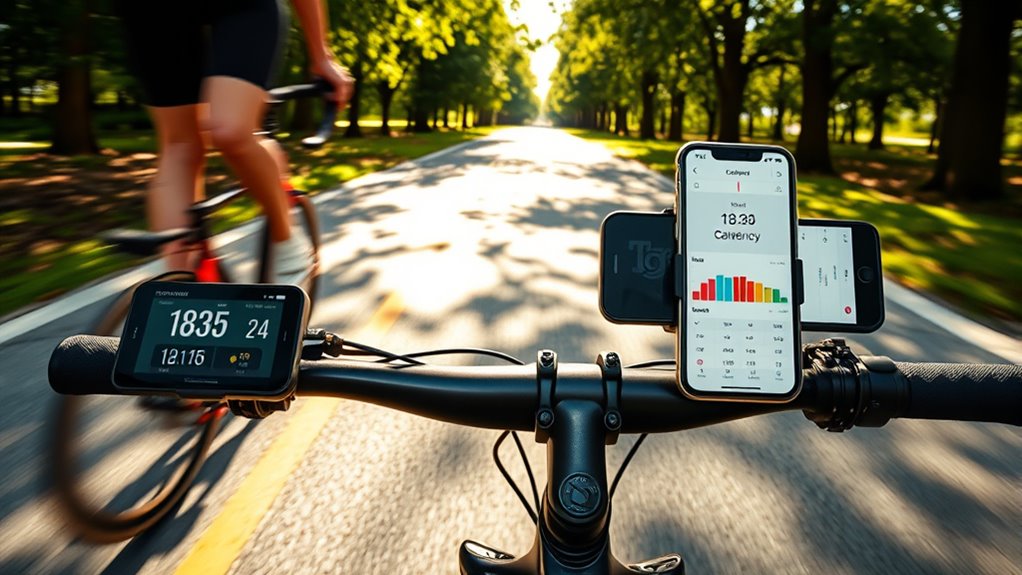
Using a bike computer or smartphone app makes tracking your cadence straightforward and real-time. To get accurate data, verify your sensor calibration is correct before riding, which helps measure pedal revolutions precisely. Proper calibration ensures your device provides reliable cadence measurements. Many devices sync seamlessly with your smartphone via Bluetooth or ANT+, allowing you to monitor your cadence live. Data synchronization is key; it ensures your ride metrics are consistently updated and stored for later analysis. Once set up, you can easily track your cadence patterns throughout your ride, identify when you’re speeding up or slowing down, and make adjustments accordingly. Cadence monitoring tools also enable you to set targets and receive feedback during your ride, enhancing your training effectiveness. Additionally, some apps incorporate performance metrics that help you analyze your overall cycling efficiency, motivating you to hit your cadence goals. Regularly reviewing your air quality during rides can help you optimize your breathing and performance, especially in varying outdoor conditions. Incorporating training techniques based on your cadence data can further improve your cycling efficiency and endurance. With these tools, improving your cadence becomes more precise, efficient, and easier to integrate into your training.
Practicing Single-Leg Pedaling Exercises to Improve Efficiency
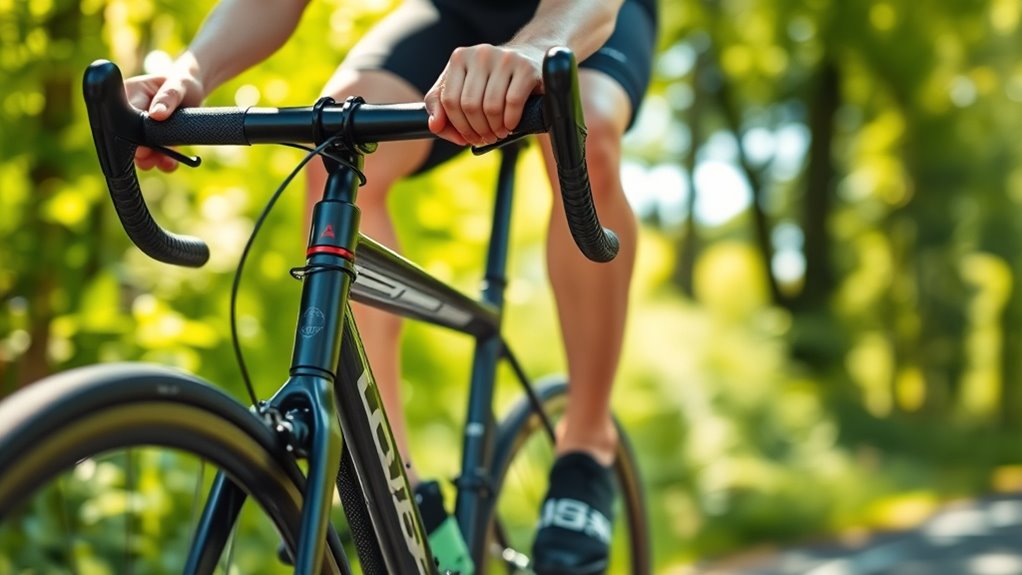
Practicing single-leg pedaling exercises can markedly boost your cycling efficiency by helping you develop better pedal control and muscle balance. These drills enhance muscle activation, ensuring the right muscles engage properly during each pedal stroke.
Single-leg pedaling improves control, balance, and muscle activation for more efficient cycling.
By isolating one leg, you focus on improving pedal biomechanics, making your pedaling smoother and more efficient. This targeted approach reveals any asymmetries or weaknesses, allowing you to correct them.
To perform the exercise, strap one foot onto the pedal and pedal with the other leg only, maintaining a steady cadence. Switch legs after a set period.
Incorporating this drill regularly helps you build strength, refine pedal mechanics, and ultimately, pedal more efficiently with less wasted energy. Additionally, paying attention to training consistency strategies can help maintain motivation and ensure steady progress in your cycling routine.
Implementing Interval Training to Enhance Pedaling Speed
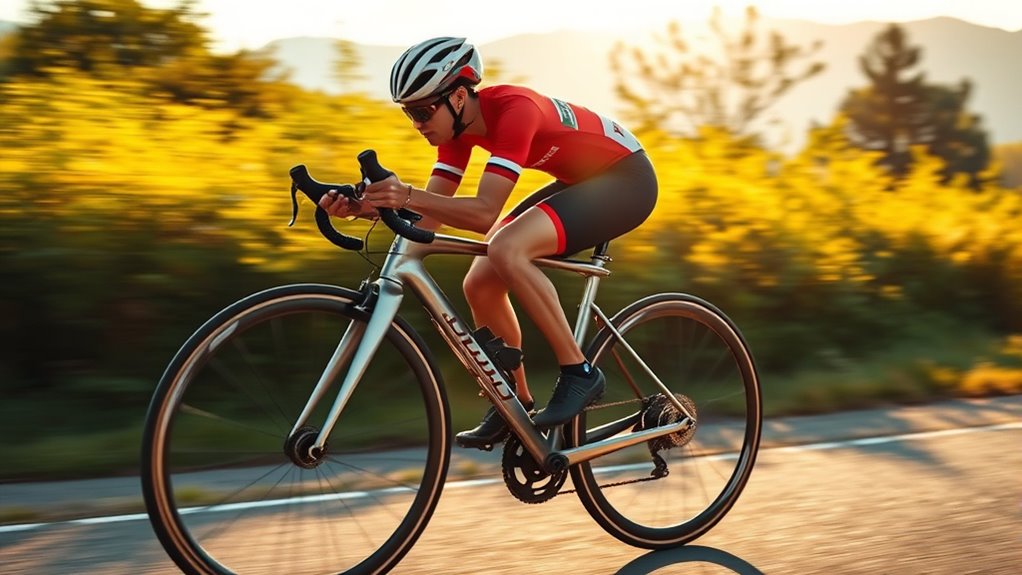
Implementing interval training is one of the most effective ways to boost your pedaling speed. By incorporating deliberate cadence variability, you challenge your muscles to adapt to different paces, improving overall efficiency.
Focus on interval pacing by alternating between high-intensity efforts and recovery periods. For example, sprint for 30 seconds at a high cadence, then pedal slowly for 60 seconds to recover.
This method pushes your limits and helps develop raw speed. Tracking your cadence during these intervals ensures you’re maintaining the right effort levels.
Over time, your ability to sustain higher cadences with control improves, making your pedaling more dynamic and responsive. Additionally, understanding cycling biomechanics can help you optimize your cadence and reduce fatigue, leading to more efficient training sessions.
Incorporating proper training techniques ensures that your interval workouts are effective and safe, helping you achieve better performance results. For example, paying attention to emotional support can motivate you to stay consistent and focused on your training goals.
Tips for Maintaining Consistent Cadence During Rides

Maintaining a consistent cadence during your ride helps improve efficiency and reduces fatigue. To manage cadence variability, focus on steady pedal strokes rather than sudden changes in speed or resistance.
Use a cadence sensor or bike computer to monitor your RPMs regularly, making small adjustments to stay within your target range. Avoid overexertion by listening to your body and easing up if you notice signs of fatigue.
Incorporate deliberate drills, such as riding at a set cadence for several minutes, to develop muscle memory and stability. Consistent cadence helps prevent unnecessary energy expenditure, making your rides more enjoyable and sustainable.
Frequently Asked Questions
How Often Should I Vary My Cadence During a Ride?
You should vary your cadence during a ride to prevent fatigue and improve efficiency. Aim to change your pedaling rhythm every 10-15 minutes, alternating between higher and lower cadences.
This helps maintain cadence consistency and keeps your muscles engaged. Listen to your body, and if you notice discomfort, adjust accordingly.
Regular variation trains your muscles and enhances overall cycling performance, making your rides more enjoyable and effective.
What Are Common Mistakes to Avoid When Improving Cadence?
In the age of chariots, mistakes still abound. When improving your cadence, avoid common errors like neglecting pedal efficiency and poor gear selection.
Don’t force a higher cadence without proper form; this can lead to fatigue and injury. Instead, focus on smooth pedal strokes and selecting gears that match your cadence.
Stay patient, listen to your body, and gradually build your rhythm for ideal efficiency and performance.
Can Cadence Training Help Prevent Cycling Injuries?
Cadence training can help prevent cycling injuries by reducing muscle fatigue, which often leads to overuse injuries. When you focus on maintaining a proper cadence, you distribute effort more evenly across your muscles, decreasing strain on any one area.
This balanced approach helps you avoid common injuries like knee or back pain. By training your cadence, you promote injury prevention, allowing you to ride longer and more comfortably without risking overexertion.
How Does Terrain Affect Optimal Cadence Choice?
Terrain considerably influences your ideal cadence choice by requiring terrain adaptation and managing cadence variability.
Uphill climbs often demand a lower cadence to conserve energy, while flat or downhill sections allow for increased cadence to maintain momentum.
You should adjust your cadence based on terrain changes, staying flexible.
Is There a Recommended Warm-Up for Cadence Drills?
For effective cadence drills, a recommended warm-up includes gentle stretching routines to loosen your muscles and prevent injury. Incorporate breathing techniques to enhance oxygen flow and prepare your body for increased effort.
Start with 5-10 minutes of easy pedaling, gradually increasing intensity. Focus on smooth, controlled movements, and guarantee your breathing is steady.
This warm-up helps you engage your muscles properly and set the stage for successful cadence improvement.
Conclusion
Remember, maintaining an ideal cadence isn’t just about riding faster; it’s about efficiency and sustainability. Studies suggest that a cadence around 80-100 rpm can reduce fatigue and improve performance. By incorporating these drills and tracking tools into your training, you’ll find it easier to keep a steady pace. Consistent practice proves that small, deliberate adjustments lead to long-term gains—so stay committed, and watch your cycling become smoother and more powerful.
